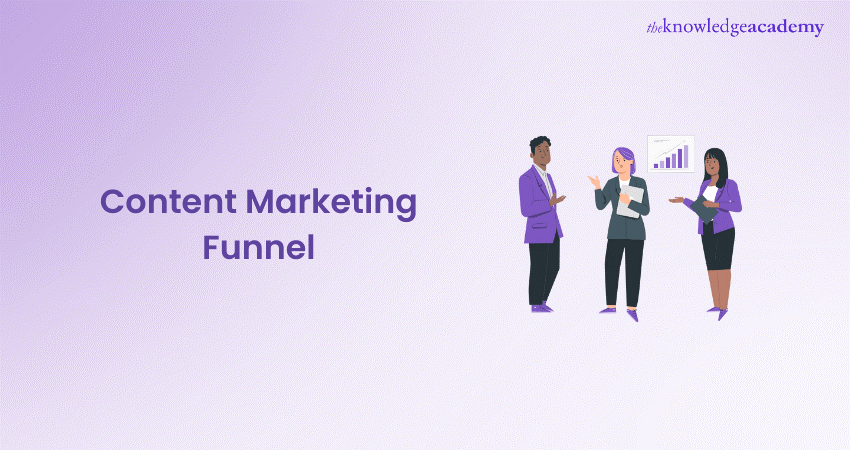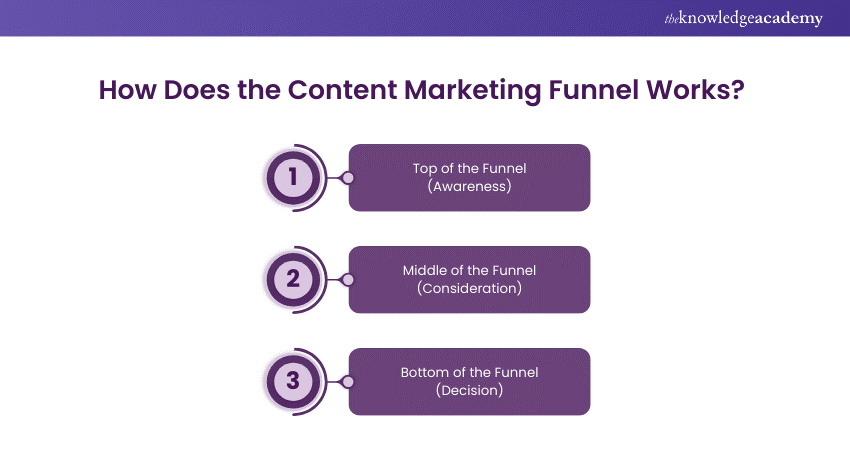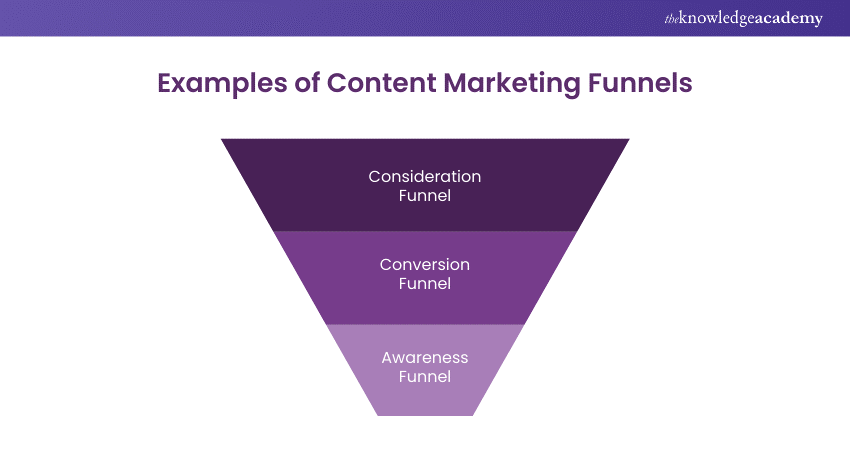We may not have the course you’re looking for. If you enquire or give us a call on 01344203999 and speak to our training experts, we may still be able to help with your training requirements.
We ensure quality, budget-alignment, and timely delivery by our expert instructors.

With the competition at a soaring high, the race to stay ahead is becoming inevitable for businesses. A lot of cutting-edge marketing strategies have evolved in this time. Content Marketing Funnel has continued to steal the scene from that spotlight. Around 96% of B2B marketers and 90% of all companies have successfully implemented content marketing strategies to fuel their businesses. Let's jump into this exciting blog to learn what is Content Marketing Funnel, its fundamental stages, its ways to create it, and notable examples.
Table of Contents
1) What is Content Marketing Funnel?
2) How Does the Content Marketing Funnel Work?
a) Top of the Funnel (Awareness)
b) Middle of the Funnel (Consideration)
c) Bottom of the Funnel (Decision)
3) Creating Content for Every Stage of the Content Marketing Funnel
4) Developing a Content Strategy for the Middle of the Funnel
5) How to Drive Traffic Through Your Content Marketing Funnel?
6) Examples of Content Marketing Funnels
7) Conclusion
What is Content Marketing Funnel?
Content Marketing Funnel is a marketing strategic framework that works to attract potential audiences, nurturing them, and transforming them into customers through leading content marketing strategies.
These include creating awareness within them, making them learn about your brand, and encouraging them to make a client conversion decision.
How Does the Content Marketing Funnel Work?
As you proceed downwards from Top of the Funnel (TOFU) to Bottom of the Funnel (BOFU), you can explore deeper into the business's strategies to delve one step closer to your conversion rates. To understand it in a better way, let’s imagine you are selling organic skincare products online.

1) Top of the Funnel (Awareness)
Content: The key examples include Blog posts, social media updates, or videos about "Benefits of Organic Skincare" or "How to Choose the Right Organic Ingredients for Your Skin".
Goal: To attract people who might be interested in organic skincare but don’t know much about your brand yet.
2) Middle of the Funnel (Consideration)
Content: The key examples include E-books, guides, or comparison articles like "Top 5 Organic Skincare Brands Compared".
Goal: Educate the interested audience about why your brand stands out, helping them consider your product as an option.
3) Bottom of the Funnel (Decision)
Content: The key examples include Customer testimonials, free trials, or discounts, such as "Get 20% off your first purchase of organic skincare products!"
Goal: To persuade the potential buyer to make the purchase.
Take your career to the next level with Sales Training! Get expert strategies to close more sales. Join now!
Creating Content for Every Stage of the Content Marketing Funnel
Knowing the Content Marketing Funnel is important for efficiently delivering the right message at the right time. In this, each funnel stage requires tailored content to effectively propel prospects through their journey. Here is how you can create content for each stage of the Content Marketing Funnel:
1) Content for the Top of the Funnel (TOFU)
TOFU content mainly targets a broader audience by increasing awareness of a problem or topic. It typically involves blog posts, social media content, infographics, and valuable educational videos. The key focus of this stage is to engage and educate rather than perform a sales operation.
2) Content for the Middle of the Funnel (MOFU)
MOFU content is designed specifically to keep leads hooked to your website by providing them with more in-depth information and solutions to a specific problem the client is facing. This stage often includes case studies, white papers, eBooks, and webinars that highlight how your product or service can help.
3) Content for the Bottom of the Funnel (BOFU)
BOFU content typically focuses on conversion rates. Its main goal is transforming leads into customers. It typically involves product demos, free trials, personalised consultations, and result-emphasising success stories.
Transform your sales game by mastering negotiation skills—sign up today for our Sales Negotiation Training!
Developing a Content Strategy for the Middle of the Funnel
To cultivate leads in a practical way, you should address their evolving needs while progressing through the funnel. This stage commands more targeted and educational content to enlighten how your solutions can meet their specific requirements. Here’s how you can develop a content strategy for the MOFU:
1) Offer Free Trials and Product Demos
Offering free trials and product demos is an extremely vital step for the potential customers to interact with your product on a first-hand basis. This approach also helps overcome doubts and showcases the practical benefits of your offering. Furthermore, it can significantly improve your engagement and conversion rates.
2) Develop Educational Content
Educational content, ranging from in-depth guides, how-to articles, and webinars, is an important context for MOFU. This content largely addresses potential customers' questions and pain points. This approach helps them understand how your product or service can solve their problems.
3) Leverage Retargeting Ads
Retargeting ads is one of the strategic ways through which you can re-engage visitors who have previously interacted with your content but haven’t converted the potential customers yet. These ads serve as timely reminders, which guides back to your website for further exploration and consideration.
4) Personalise Content for Your Audience
Personalised content, ranging from tailored emails to product recommendations, resonates more with the audience to improve the engagement rates. By incorporating insights, ranging from browsing behaviour to past interactions, you can easily craft more relevant content that could meet specific customer needs. This approach increases the likelihood of moving prospects further down the funnel.
5) Use Case Studies and Customer Testimonials
Case studies and customer testimonials are some of the powerful tools that demonstrate real-life success stories of your product or service. By showcasing how others have benefited, you provide potential customers with the social proof needed to build credibility and encourage decision-making.
Boost your sales performance with analytics—get started with our Sales Analytics Training now!
How to Drive Traffic Through Your Content Marketing Funnel?
Attracting visitors requires a mix of strategies that are tailored to reach active audiences. Here is how you can drive traffic through your Content Marketing Funnel:
1) Utilising Social Media
Social media is a great medium to improve and drive results. By sharing engaging and relevant content on platforms where you have target audiences, you can increase brand awareness and generate leads. For this, you must use a mix of organic posts, paid ads, and social media engagement to amplify your reach.
2) Maximising Organic Search
Optimising content for search engines is a crucial way to increase visibility in search results (Search Engine Optimisation). By selecting relevant keywords and creating high-quality content, you can improve rankings and drive consistent organic traffic. Try to focus on SEO strategies, such as on-page optimisation, meta tags, and internal linking to boost discoverability.
3) Generating Referral Traffic
Referral traffic comes from other websites that are able to link to your content. Building relationships with industry-related sites and sharing valuable resources can drive more visitors to your site. In that, guest blogging, strategic partnerships, and link-building efforts are key tactics for elevating the referral traffic.
4) Optimising with SEO
SEO is essential for enhancing content visibility across search engines. Implementing keyword research, technical SEO improvements and high-quality backlinks ensures your content ranks well and attracts targeted visitors. Regularly updating and optimising your site improves search rankings and drives sustained traffic.
Master Content Marketing Interview Questions and Answers to land your next role in content marketing. Start practicing and get ready for your interview!
Examples of Content Marketing Funnels
To build an effective content marketing strategy, it's essential to understand the various types of funnels that demonstrate the different stages of the customer's journey. Here are the examples of Content Marketing Funnels:

1) The Consideration Funnel
The consideration funnel targets prospects who are exploring potential solutions. At this stage, content like case studies, product demos, and webinars are effective. The goal is to demonstrate value and answer questions, helping prospects understand how your offering can address their specific needs.
2) The Conversion Funnel
The conversion funnel aims to turn prospects into customers. It involves content like product comparisons, pricing pages, and free trials, which focus on convincing leads to take action. Clear calls-to-action (CTAs) and tailored follow-ups are essential to drive conversions.
3) The Awareness Funnel
The awareness funnel focusses majorly on attracting potential customers who are unfamiliar with your brand. The key contents in this category include blogs, social media posts, and videos that educate or entertain. The major aim of awareness funnel is to build brand visibility and introduce prospects to your offerings.
Learn to sell value, not just products- kickstart your Value-Based Selling Training today!
Conclusion
We hope you now understand the Content Marketing Funnel and its pivotal role in driving effective conversions. By thoroughly implementing this strategy, you can not only boost your brand awareness but also ensure a seamless journey for leads at every stage. Moreover, you can effectively engage your audience and drive sustainable growth through tailored content, strategic nurturing, and consistent optimisation, ultimately reaping the Benefits of Content Marketing, such as increased brand visibility, improved customer relationships, and enhanced ROI
Drive sales through meaningful relationships—start your journey with our Relationship Sales Course today!
Frequently Asked Questions
What is the Funnel Technique?

The funnel technique is a marketing approach that propels potential customers towards conversion from awareness. It uses a step-by-step procedure, which begins with broad content. This approach is created to attract leads and gradually narrows down to more targeted content that influences buying decisions.
What is the Funnel Principle?

The funnel principle is a method that helps potential customers lead through a structured process, beginning from general awareness to making a buying decision. It focuses on creating content that narrows down the audience’s interest step-by-step, guiding them from broad engagement to specific solutions, ultimately converting them into customers.
What are the Other Resources and Offers Provided by The Knowledge Academy?

The Knowledge Academy takes global learning to new heights, offering over 30,000 online courses across 490+ locations in 220 countries. This expansive reach ensures accessibility and convenience for learners worldwide.
Alongside our diverse Online Course Catalogue, encompassing 19 major categories, we go the extra mile by providing a plethora of free educational Online Resources like News updates, Blogs, videos, webinars, and interview questions. Tailoring learning experiences further, professionals can maximise value with customisable Course Bundles of TKA.
What is The Knowledge Pass, and How Does it Work?

The Knowledge Academy’s Knowledge Pass, a prepaid voucher, adds another layer of flexibility, allowing course bookings over a 12-month period. Join us on a journey where education knows no bounds.
What are the Related Courses and Blogs Provided by The Knowledge Academy?

The Knowledge Academy offers various Sales Courses, including Sales Negotiation Training, Sales Analytics Training, and Relationship Sales Training. These courses cater to different skill levels, providing comprehensive insights into Storytelling Framework.
Our Business Skills Blogs cover a range of topics related to leadership, among others, offering valuable resources, best practices, and industry insights. Whether you are a beginner or looking to advance your Business Management skills, The Knowledge Academy's diverse courses and informative blogs have got you covered.
Upcoming Business Skills Resources Batches & Dates
Date
 Sales Bootcamp
Sales Bootcamp
Fri 14th Mar 2025
Fri 9th May 2025
Fri 11th Jul 2025
Fri 12th Sep 2025
Fri 14th Nov 2025






 Top Rated Course
Top Rated Course



 If you wish to make any changes to your course, please
If you wish to make any changes to your course, please


